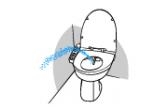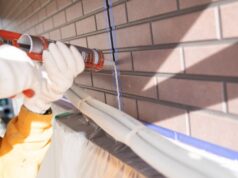
They’re not common in Australia, but bidets are very popular in some parts of the world. Find out how a bidet works, what it’s used for and how to have one installed in your home.
Bidets can take a little getting used to if you’ve never used one before, but they can also improve toilet hygiene significantly and add a touch of panache to your bathroom. Bidets were invented in France in the 1700’s as a means of cleansing the genital area between weekly baths. The word ‘bidet’ derived originally from French, and translates to ‘pony’ – a reference to the method of sitting astride a bidet like a horse to use it.
Bidets really became popular in the 1960’s though, when they began to be incorporated into toilets, removing the need for a separate facility. Given the modern obsession with cleanliness, it’s hard to see why bidets are not more popular as they’re widely regarded as a far more hygienic option than toilet paper.

Types of bidet
There are three main types of bidet in use today – the standalone bidet, the attached bidet and the detached bidet.
The standalone bidet is the one we likely think of when we hear the word. Using a separate bowl to the toilet and often positioned just next to it, this bidet was the only model available for much of the bidet’s history. It usually consists of one or two taps, and looks something like a low mounted sink. The main drawbacks to this bidet type are that:
- you need to get off the toilet to use it
- it requires more space
- it requires extra cleaning
- it’s usually a lot pricier than an attached model.
Of course, if you’re after a traditional European style bathroom, a standalone bidet may be a nice addition.
Attached bidets are built into the toilet design and are often connected to various other electrical devices which can alter the spray from a jet to a vapour, change the temperature of the water and even provide air drying facilities. They will usually require an electrical connection, as the control panel requires power to work so if you intend to buy one, find out first how it’s going to be connected. These types of bidets are less expensive than a standalone bidet and remove the need to get up and move to another area.
Detached bidets are not designed as part of the toilet, and are sold separately. These less expensive varieties are connected to the toilet under the seat and can be moved around when necessary. Most detached bidets provide a simple jet spray and don’t have all the additional features that you’d find in a higher end attached type, but can be just as effective as the others without costing a fortune. These bidets will either use hot or cold water, depending on which mains supply you connect them to.
Toilet hoses
Another alternative to the bidet which is very common throughout Asia and the Middle East is a simple hose with an aerated outlet, connected to the wall (sometimes referred to in marketing material as a ‘handheld bidet’). This has the twin benefits of mobility and economy; it is very easy to manoeuver one of these around and costs much less to install. If you’re planning on installing a hose / handheld bidet, you will also need to waterproof and tile the floor and walls.
Problems to avoid and what to look for
Backflow prevention is a critical area that your plumber needs to consider when installing any bidet-type device, as there is potential for cross-contamination. With more and more after-market bidet seats (some with flexible hoses attached) coming onto the market, particular care needs to be taken to prevent backflow.
Backflow occurs when there is a sudden pressure drop in the water main outside of your property (e.g. there is a break in the system in your street). The effect of this may result in water within the fixtures (bidets, toilets, hoses, irrigation systems etc.) in your home being syphoned back into the public water main. This can potentially pollute your (and your neighbours’) potable water system – and no-one wants to drink water from their neighbour’s bidet!
Your plumber needs to install a suitable backflow prevention device that meets the plumbing regulatory requirements, if the unit has no device built-in.
The safe way is to select only WaterMark approved bidets. Look for the approval number/mark on any plumbing product or check at the Standards Australia website prior to purchasing.




